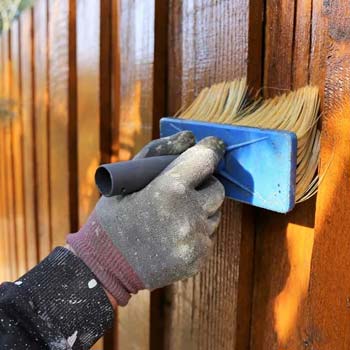The secret to a successful fence staining project lies in the timing, weather conditions, and choice of stain. A beautifully stained fence not only adds an attractive finishing touch to your property but also protects your investment in privacy and longevity of your exteriors. In this article, you will learn the best time to stain a fence, along with the ultimate steps to ensure a flawless and long-lasting result for your wood fence staining project.
When is the Best Time to Stain your Fence?
To stain a fence the best season is during the summer when temperatures are between 40-80 °F for the best results, and there are a few days of consecutive dry and warm weather. This enables the stain to dry properly which avoids flaking.
However, applying stain in full sun should be avoided as it may lead to lap marks and weak adhesion.
Ideal Weather Conditions for Fence Staining
The success of your fence staining project heavily depends on certain environmental factors. Taking into account for elements like temperature, sun exposure, and moisture prior to staining wooden fences can lead to superior results.
Temperature Factors
Temperature is a key factor in fence staining. Adhering to the manufacturer’s guidelines and avoiding extreme cold or hot temperatures is crucial for a successful outcome. The recommended temperature range for applying fence stain is between 50 and 80 °F. Too cold, and the stain may not dry properly, leading to flaking or fading. Too hot, and you risk lap marks on the fence.
Staining with a good quality stain within the recommended temperature range guarantees a durable and appealing finish.
Sun Exposure
Sun exposure also plays a significant role in fence staining. Staining your cedar fence during mild, cloudy days is recommended to avoid premature drying and peeling. Direct sunlight may affect the penetration of stain into the wood, causing weak adhesion and a less durable finish.
Staining a fence under suitable weather conditions promotes deep penetration and adhesion, leading to a durable outcome.
Moisture Considerations
Moisture is another critical factor to consider when staining a fence. Dry wood allows for better stain penetration, while wet or moist wood may impede penetration and cause issues such as uneven application or adhesion problems. A moisture content of around 12-17% is ideal for optimal stain penetration.
To determine if the fence is ready for staining, perform a water test by placing a drop of water on the fence. If the water is absorbed quickly, the fence is ready to be stained.
Staining a New Wood Fence
For new wood fences, such as pressure-treated pine or cedar, you should allow a waiting period (1-3 months for pressure-treated pine, 1-2 months for cedar) before staining. This waiting period allows excess moisture to escape, ensuring the fence is dry and ready for staining. When choosing the materials for your fence, consider using pressure treated lumber for added durability and resistance to decay.
Conduct a water test to confirm your fence is ready for staining, as mentioned earlier.
Older Wooden Fences
Older wooden fences can still be stained, but they may require additional preparation and maintenance. Before staining an older fence, it’s essential to clean and prepare the surface to achieve the best results. However, if your fence is worn beyond repair, it’s not recommended to stain it.
Preparation before Staining your Fence
Power washing your fence before staining ensures a clean surface for better stain adherence. Use a pressure setting of approximately 2500 PSI when power washing a wooden fence before staining.
After power washing, allow the fence to become completely dry for a minimum of 48 hours to ensure all absorbed water has evaporated from the wood.
You fence is one of the first things a visitor sees when visiting your home or workplace. To make it look beautiful and for its extended lifespan, you should hire a professional fence staining company. Look no further than McCoy\’s Deck Staining and Pressure Washing for fence staining and any other pressure or power washing projects.
Benefits of Staining Your Fence
Staining your fence provides various advantages such as increased durability, improved aesthetics, and safeguarding your investment. Maintaining your fence’s lifespan through staining helps protect your privacy and safety.
Extended Lifespan
A stained fence lasts longer by preventing rot, warping, and UV damage. In comparison to an unstained fence, a stained fence can last up to 3 years before needing to be reapplied.
Regular fence staining every two to three years can significantly enhance the durability of your fence and increase its overall lifespan. In fact, a well-maintained fence can last for years, making new fence installation less frequent.
Enhanced Appearance
Staining enhances the appearance of your fence by hiding imperfections and providing a uniform look. Some vibrant hues that bring out the natural beauty of the wood and protect against fading include:
- Redwood
- Pecan
- Auburn
- Black
- Walnut
- Chestnut brown
A well-stained new fence not only improves its aesthetics but also adds to your property’s curb appeal, making fence installation a valuable investment.
Protection for Your Investment
By staining your fence, you protect your investment in privacy and safety. Regular staining preserves the wood’s color, prevents fading, repels water, and prevents splitting, ensuring your fence remains a valuable asset to your property for years to come.
Summary
In conclusion, the key to a successful fence staining project lies in the timing, weather conditions, and the right stain choice. By considering these factors and following the suggested application techniques, you can enhance the appearance, extend the lifespan, and protect your investment in privacy and safety. With proper care and maintenance, your beautifully stained fence will stand the test of time.

